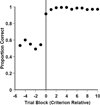Fading perceptual resemblance: a path for rhesus macaques (Macaca mulatta) to conceptual matching?
- PMID: 24076537
- PMCID: PMC3809328
- DOI: 10.1016/j.cognition.2013.08.001
Fading perceptual resemblance: a path for rhesus macaques (Macaca mulatta) to conceptual matching?
Abstract
Cognitive, comparative, and developmental psychologists have long been intrigued by humans' and animals' capacity to respond to abstract relations like sameness and difference, because this capacity may underlie crucial aspects of cognition like analogical reasoning. Recently, this capacity has been explored in higher-order, relational matching-to-sample (RMTS) tasks in which humans and animals try to complete analogies of sameness and difference between disparate groups of items. The authors introduced a new paradigm to this area, by yoking the relational-matching cue to a perceptual-matching cue. Then, using established algorithms for shape distortion, the perceptual cue was weakened and eliminated. Humans' RMTS performance easily transcended the elimination of perceptual support. In contrast, RMTS performance by six macaques faltered as they were weaned from perceptual support. No macaque showed evidence of mature RMTS performance, even given more than 260,000 training trials during which we tried to coax a relational-matching performance from them. It is an important species difference that macaques show so hesitant a response to conceptual relations when humans respond to them so effortlessly. It raises theoretical questions about the emergence of this crucial capacity during humans' cognitive evolution and during humans' cognitive development.
Keywords: Comparative cognition; Concept learning; Primate cognition; Relational matching; Same-different.
Copyright © 2013 Elsevier B.V. All rights reserved.
Figures









Similar articles
-
Breaking the perceptual-conceptual barrier: Relational matching and working memory.Mem Cognit. 2019 Apr;47(3):544-560. doi: 10.3758/s13421-018-0890-9. Mem Cognit. 2019. PMID: 30632014 Free PMC article.
-
Analogical reasoning and the differential outcome effect: transitory bridging of the conceptual gap for rhesus monkeys (Macaca mulatta).J Exp Psychol Anim Behav Process. 2011 Jul;37(3):353-60. doi: 10.1037/a0022142. J Exp Psychol Anim Behav Process. 2011. PMID: 21574737 Free PMC article.
-
Crows spontaneously exhibit analogical reasoning.Curr Biol. 2015 Jan 19;25(2):256-260. doi: 10.1016/j.cub.2014.11.063. Epub 2014 Dec 18. Curr Biol. 2015. PMID: 25532894
-
Social modulation of cognition: Lessons from rhesus macaques relevant to education.Neurosci Biobehav Rev. 2017 Nov;82:45-57. doi: 10.1016/j.neubiorev.2016.12.002. Epub 2016 Dec 5. Neurosci Biobehav Rev. 2017. PMID: 27923731 Review.
-
Species comparative studies and cognitive development.Trends Cogn Sci. 2005 Mar;9(3):118-25. doi: 10.1016/j.tics.2005.01.004. Trends Cogn Sci. 2005. PMID: 15737820 Review.
Cited by
-
Breaking the perceptual-conceptual barrier: Relational matching and working memory.Mem Cognit. 2019 Apr;47(3):544-560. doi: 10.3758/s13421-018-0890-9. Mem Cognit. 2019. PMID: 30632014 Free PMC article.
-
I scan, therefore I decline: The time course of difficulty monitoring in humans (homo sapiens) and macaques (macaca mulatta).J Comp Psychol. 2018 May;132(2):152-165. doi: 10.1037/com0000100. Epub 2018 Apr 16. J Comp Psychol. 2018. PMID: 29658725 Free PMC article.
-
Rhesus macaques (Macaca mulatta) exhibit the decoy effect in a perceptual discrimination task.Atten Percept Psychophys. 2015 Jul;77(5):1715-25. doi: 10.3758/s13414-015-0885-6. Atten Percept Psychophys. 2015. PMID: 25832189 Free PMC article.
-
A Dissociative Framework for Understanding Same-Different Conceptualization.Curr Opin Behav Sci. 2021 Feb;37:13-18. doi: 10.1016/j.cobeha.2020.06.004. Epub 2020 Jul 15. Curr Opin Behav Sci. 2021. PMID: 34124319 Free PMC article.
-
Perceptual category learning of photographic and painterly stimuli in rhesus macaques (Macaca mulatta) and humans.PLoS One. 2017 Sep 29;12(9):e0185576. doi: 10.1371/journal.pone.0185576. eCollection 2017. PLoS One. 2017. PMID: 28961270 Free PMC article.
References
-
- Barrett L. Out of their heads: Turning relational reinterpretation inside out. Behavioral and Brain Sciences. 2008;31:130–131.
-
- Beran MJ. Monkeys (Macaca mulatta and Cebus apella) track, enumerate, and compare multiple sets of moving items. Journal of Experimental Psychology: Animal Behavior Processes. 2008;34:63–74. - PubMed
-
- Bickerton D. Darwin’s last word: How words changed cognition. Behavioral and Brain Sciences. 2008;31:132.
-
- Brooks DI, Wasserman EA. Same/different discrimination learning with trial-unique stimuli. Psychonomic Bulletin & Review. 2008;15:644–650. - PubMed
Publication types
MeSH terms
Grants and funding
LinkOut - more resources
Full Text Sources
Other Literature Sources

